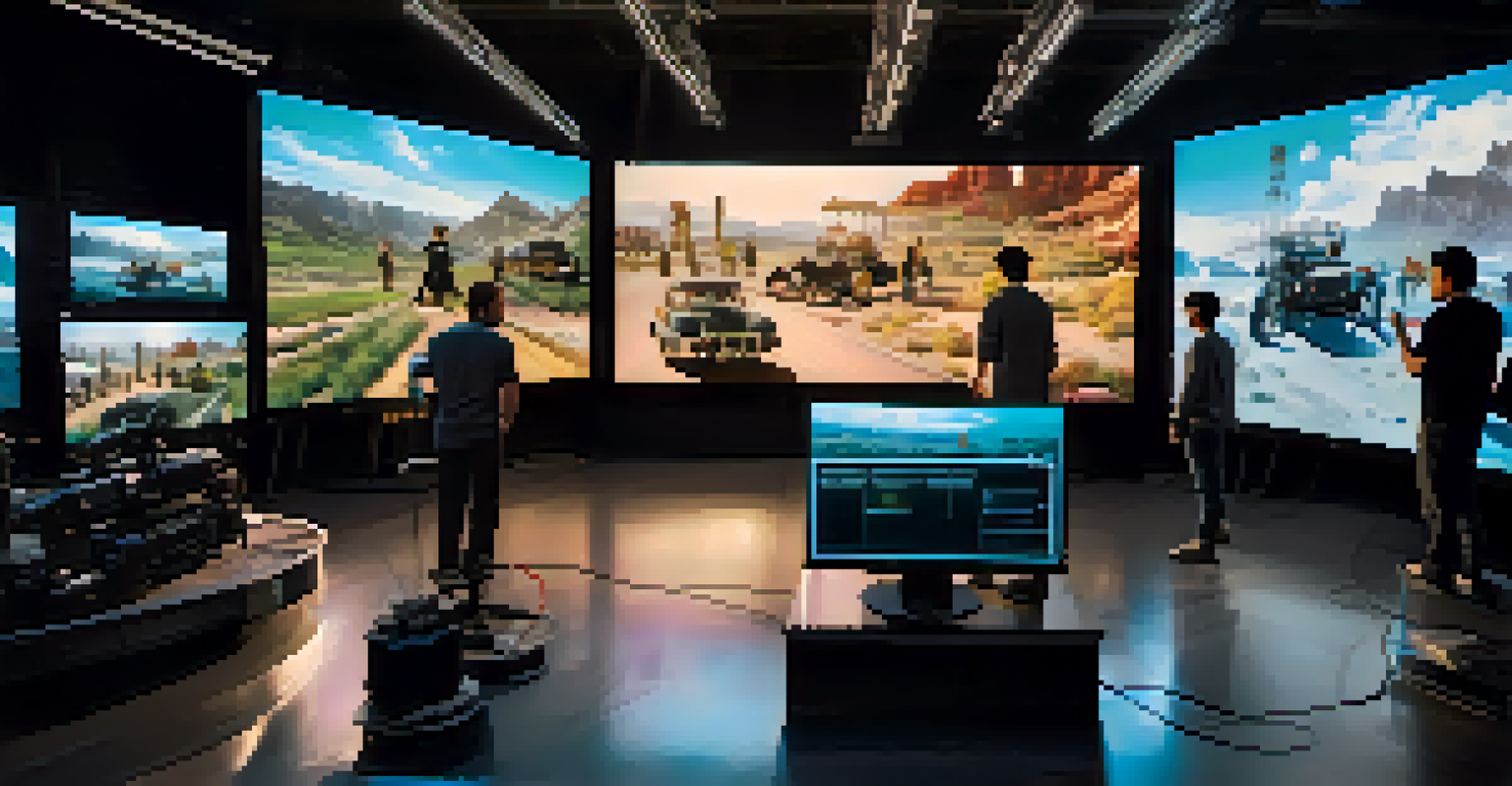The Impact of 5G Technology on Future Film Distribution Methods

Understanding 5G Technology and Its Basics
5G technology represents the fifth generation of mobile networks, promising faster speeds, lower latency, and greater reliability. Unlike its predecessor, 4G, which struggles with high-demand scenarios, 5G can manage multiple connections seamlessly. This capability opens doors for innovative applications in various industries, including film.
The future of film is not in the theaters but in our pockets, where technology meets creativity.
At its core, 5G utilizes advanced technologies like millimeter waves and massive MIMO (Multiple Input Multiple Output) to enhance data transfer rates. Imagine streaming a full-length movie in seconds instead of minutes; that’s the potential impact of 5G. This leap in technology not only improves user experience but also enables filmmakers to explore new distribution avenues.
As we dive deeper into the film industry, understanding 5G’s foundational aspects is crucial. It sets the stage for how filmmakers and distributors can leverage these advancements to reach audiences more effectively. With this groundwork laid, let’s explore how 5G is poised to change film distribution.
Faster Downloads and Streamlined Viewing Experiences
One of the most immediate impacts of 5G is the incredible increase in download speeds. This means that users can download or stream high-definition films without buffering, making for a more enjoyable viewing experience. Imagine watching the latest blockbuster on your phone without a hint of lag; that’s the promise of 5G.

This efficiency extends beyond mere convenience. Filmmakers can distribute their content in higher resolutions, such as 4K or even 8K, reaching audiences with stunning visuals. Similarly, the ability to stream films without delays opens up opportunities for live events and premieres, giving fans immediate access to new releases.
5G Enhances Film Viewing Experience
With lightning-fast download speeds, 5G allows users to stream high-definition films seamlessly, transforming how audiences enjoy movies.
Moreover, as the demand for on-the-go content rises, 5G enables a shift towards mobile-first viewing. This change will encourage filmmakers to create content that caters to mobile audiences, further diversifying how films are distributed and consumed.
The Rise of Augmented and Virtual Reality Films
5G technology is not just about faster downloads; it also enhances the potential for augmented reality (AR) and virtual reality (VR) in filmmaking. With its low latency, 5G allows for real-time interactions in immersive environments, offering audiences a unique way to engage with films. Picture stepping into your favorite movie scene—this is becoming more feasible.
5G is a game changer for the film industry, enabling a new era of storytelling and distribution.
As filmmakers experiment with AR and VR, the storytelling possibilities expand dramatically. Imagine a horror film where you can interact with the environment or a documentary that immerses you in the setting. This level of engagement could redefine how stories are told and experienced.
With the advent of 5G, the production and distribution of AR and VR content become more practical. Filmmakers can push the boundaries of creativity, delivering experiences that captivate audiences in entirely new ways, thus reshaping the industry landscape.
Enhanced Global Distribution and Accessibility
5G technology promises to bridge the gap in global film distribution, making it easier for films to reach audiences worldwide. With improved connectivity, even remote areas can access high-quality content, democratizing film consumption. This means a filmmaker in a small town can share their work with a global audience effortlessly.
Moreover, the enhanced speed of 5G can facilitate quicker translations and subtitle integrations, making films accessible to diverse populations. Filmmakers now have the opportunity to cater to international markets without extensive delays, fostering a more inclusive film landscape.
AR and VR Revolutionize Storytelling
5G technology enables real-time interactions in augmented and virtual reality, providing filmmakers with innovative storytelling possibilities.
As a result, a new wave of global storytelling can emerge, where different cultures and narratives are shared across borders. This accessibility not only benefits filmmakers but also enriches audiences by exposing them to a variety of perspectives and stories.
Impact on Film Marketing and Promotion Strategies
With the capabilities of 5G, film marketing strategies can evolve significantly. Faster data transfer means trailers and promotional content can reach audiences instantly, maximizing engagement. Imagine receiving a trailer on your phone just moments after its release, creating immediate buzz and excitement.
Additionally, the use of interactive content becomes more viable. Marketers can create campaigns that encourage audience participation, such as polls or AR experiences that tie directly into the film’s theme. This level of engagement can foster a deeper connection between the audience and the film.
As filmmakers and marketers embrace these new strategies, they will likely see improved results from their promotional efforts. By leveraging the power of 5G, the film industry can create a dynamic and interactive marketing landscape that resonates with viewers.
Shifts in Viewer Behavior and Expectations
As 5G technology becomes mainstream, viewer behavior is bound to shift. With the expectation of instant access to content, audiences may become less patient with traditional distribution methods such as theater releases or DVD sales. Instead, they will seek on-demand services that offer immediate access to films.
This change in behavior will challenge filmmakers to adapt their release strategies. They might opt for simultaneous releases across multiple platforms, allowing viewers to choose how they want to watch. This flexibility caters to diverse preferences and enhances audience satisfaction.
Global Distribution Becomes Accessible
5G bridges the gap in film distribution, allowing creators from remote areas to share their work with a worldwide audience effortlessly.
Moreover, as people grow accustomed to higher quality streaming and interactive experiences, filmmakers will need to continuously innovate. The pressure to meet these evolving expectations will drive creativity and experimentation in filmmaking and distribution.
Potential Challenges and Considerations for Filmmakers
Despite the exciting opportunities 5G presents, there are challenges that filmmakers must navigate. The shift towards digital distribution may threaten traditional theaters, prompting concerns about the future of cinematic experiences. Filmmakers will need to find a balance between reaching audiences online and preserving the magic of the theater.
Additionally, with increased access comes the risk of content saturation. As more films are distributed through digital platforms, standing out in a crowded marketplace becomes a significant challenge. Filmmakers must develop unique marketing and distribution strategies that capture audience attention.

Finally, the reliance on technology raises concerns about data privacy and security. As audience interactions become more integrated with film experiences, protecting user data will be crucial. Filmmakers and distributors must prioritize these considerations to ensure a safe and enjoyable experience for viewers.
The Future of Film Distribution in a 5G World
Looking ahead, the future of film distribution is undoubtedly intertwined with 5G technology. Its capabilities will enable filmmakers to experiment with new formats and interactive storytelling, creating richer experiences for audiences. As we embrace this digital era, the ways we consume and engage with films will continue to evolve.
Furthermore, the global reach of 5G opens doors for diverse storytelling, allowing filmmakers from different backgrounds to share their narratives with the world. This inclusivity will enhance the richness of the film landscape, offering audiences a broader array of perspectives.
5G Revolutionizes Film Distribution
5G technology enhances download speeds and connectivity, enabling filmmakers to distribute high-quality content seamlessly.
Ultimately, the impact of 5G on film distribution is just beginning to unfold. As filmmakers, distributors, and audiences adapt to these changes, we can expect an exciting future that redefines how we experience movies.